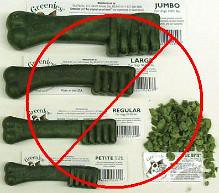
Why Greenies® Are Dangerous For Your Dog
Part I
My friend, Jess from asnkadogs.com/ is joining me in spreading the "Real" truth about Greenies®. Here is part of her great article that you can find in its entirety on my Whole Dog News Blog or Jess's blog, Common Scents You will want to read the whole article, it is very well done :-)
How Greenies came to be
In the late 1990’s, Dr. Joe and Judy Roetheli weren’t overly fond of their Samoyed’s dog breath and devised a dog treat to be an effective alternative to brushing a dog’s teeth. In 1998, the dog treat, Greenies, was introduced and gave their competitors a run for their money with 325 million treats being sold around the world last year alone, overtaking the #1 dog treat spot by a landslide. Greenies are manufactured by a Missouri-based company called S&M NuTec.
A lawsuit
A rescued Miniature Dachshund, “Burt”, died July 25, 2005 at the age of 4. A Greenie was found obstructing his intestines. Burt died 48 hours after the obstruction was surgically removed. Burt’s family filed a lawsuit against S&M NuTec on November 30, 2005.
Common sense
In my non-professional opinion; Greenies pose a danger to every dog due to the biological digestive process of the animal. Asking owners, as the manufacturer does in the fine print, to make sure their dogs don’t gulp the dog treat known as “doggie crack” is ludicrous. It goes against the dog’s own nature and may not be a possibility. Part I of Why Greenies Are Dangerous for Your Dog is dedicated to canine digestion, intestinal blockage, and the lack of common sense of the manufacturers. I urge my readers to take my conclusions seriously and ask your vets for a professional opinion.
Digestion—a quick lesson
Canine digestion is very different than human digestion. Wolves eat their food quickly in an attempt to protect it from being stolen. They do not use their jaw muscles and teeth for chewing; instead they rip off large sections of meat and swallow them whole. The function of canine teeth is to cut, much like a knife. Wolf digestion is quite efficient for its purpose, objects not broken down become encased in undigested fur, and thus the intestines are protected from injury.
Wolves and dogs, as almost-true carnivores, do not have salivary amylase, an enzyme that exists in human saliva and begins the digestive process. Salivary amylase is an enzyme, a “biological catalyst” increasing the rate of a chemical reaction. From what I understand, dogs, unlike humans, will digest any starches/carbohydrates they eat in the small intestine where amylase and other enzymes *are* found and produced by the pancreas.
A dog’s saliva creates an efficient lubricant that glazes food and helps with swallowing quickly. No chemical breakdown is occurring; the digestive chemical process has not begun. This is how dogs can gulp down their food. They are biologically made to do so.In the stomach, digestive enzymes are added to the consumed food, proteins are beginning to break down in the high acid ph of the stomach. The mucus that lubricated the food now protects the lining of the stomach wall from being digested by the enzymes. The food that is primarily protein should now be a thick milky liquid and will pass into the duodenum, the first part of the small intestine. The main site for digestion of carbohydrates is in the small intestine (the workhorse of the digestive system) and enzymes, such as amylase, are added. The broken down nutrients are then absorbed across the wall of the intestine and into the blood stream.
Please go read the whole article Here
Jessica Tighe
www.asankadogs.com
This article can only be reproduced when proper credit is given to the author and the website link is included.